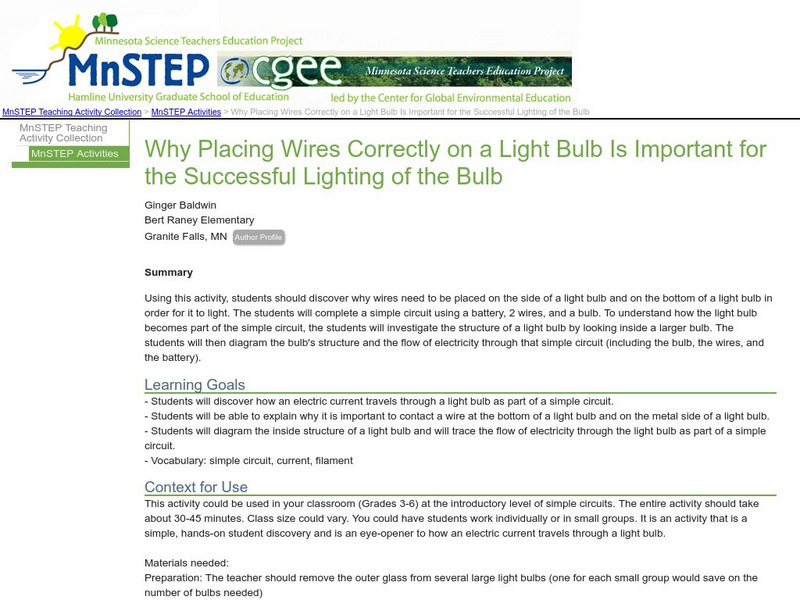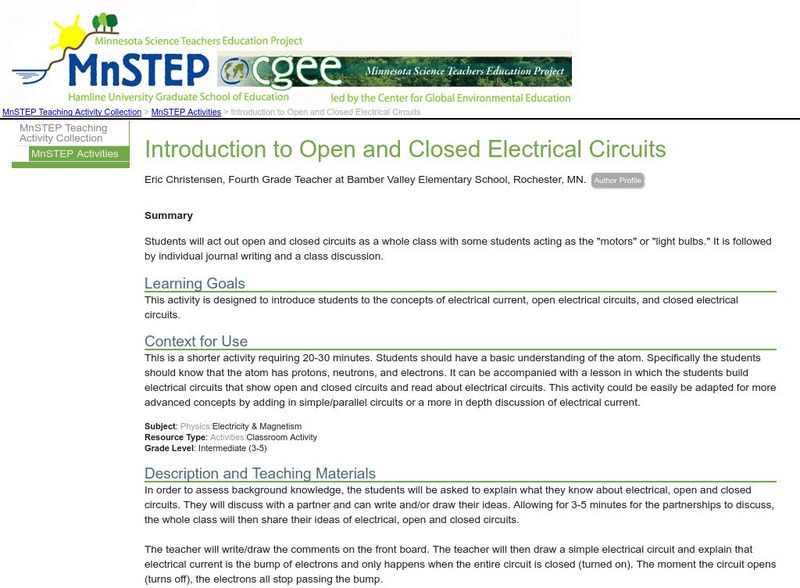Curated OER
Making Energy "trails"
Students explore ten different stations that demonstrate either chemical, kinetic, or mechanical energy. They examine the way energy is transferred during each station's hands-on activity. Stations include vinegar and baking soda,...
Curated OER
Solar Matters
Students design an energy resource wheel and demonstrate how to use it to access information about renewable and nonrenewable energy sources.
Curated OER
OHM's Law
Students study the relationship between current, voltage and resistance in a series circuit. In this investigative activity students watch a demonstration and see how voltage is measured and see what OHM's law is.
Curated OER
How Green Are We?
Students identify and interpret the importance of energy efficiency in connection with air pollution. They communicate with families and peers about ways to more effectively contribute to the reduction of air pollution. Finally,...
Curated OER
Simple Circuits
Students investigate how series and parallel circuits work. In this physics lesson plan, students build their own simple circuits and compare their characteristics. They explain the importance of circuit breakers in household circuits.
Curated OER
Energy Transfer
Students investigate the properties of heated air. They make predictions about what they think makes the wind blow on a worksheet, and conduct two experiments to demonstrate the properties of heated air. Students heat a bottle until a...
Climate Literacy
Clean: Compact Fluorescent Light Bulbs Cost Benefit Analysis
This analysis activity allows students to calculate electrical usage in home lighting, and create a cost-benefit analysis for cost and energy savings by replacement of incandescent light bulbs with compact fluorescent or LED light bulbs.
Science Education Resource Center at Carleton College
Serc: How Do Light Bulbs Work?
A guided inquiry that involves observation of the parts of a light bulb in a lab.
Science Education Resource Center at Carleton College
Serc: Mn Step: Why Placing Wires Correctly on a Light Bulb Is Important
Students will learn about simple electric circuits as they investigate the structure of a light bulb and how electricity flows through it.
Science Education Resource Center at Carleton College
Serc: Investigating Electricity
In this interactive activity, young scholars will explore electricity and be able to design and create a complete electrical circuit. Students will also learn what is necessary to light a light bulb. Creative thought, ideas, and,...
Science Education Resource Center at Carleton College
Serc: Introduction to Open and Closed Electrical Circuits
This activity introduces students to the concepts of electrical current and open and closed circuits. Students will act out open and closed circuits as a whole class with some students acting as the "motors" or "light bulbs."
US National Archives
Nara: Teaching With Documents: Telephone and Light Patent Drawings
A lesson plan about Alexander Graham Bell's patent for the telephone and Thomas Edison's patent for the electric lamp. Contains good background information and historically pertinent documents. It also discusses the role corporations...
Science Education Resource Center at Carleton College
Serc: Investigating Electricity: Building Circuits in Elementary Science Class
In this exploration activity, students compare the difference between series circuits and parallel circuits using wire, light bulbs, and D batteries.
Library of Congress
Loc: Learning Page: Thomas Edison
This resource provides lesson plans and information about Thomas Edison and his inventions.
TryEngineering
Try Engineering: Series and Parallel Circuits
The core of this instructional activity is simple circuits and the differences between parallel and series circuit design. Students perform experiments to test the differences between the two circuit designs using low voltage light bulbs.















